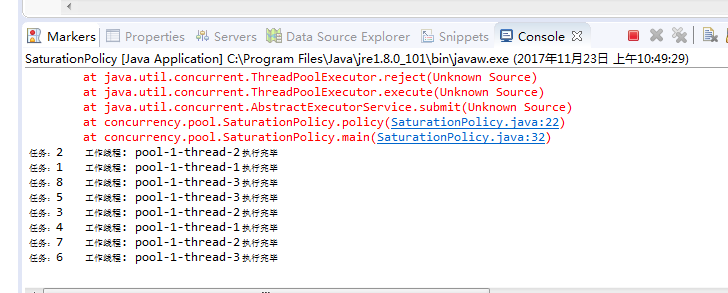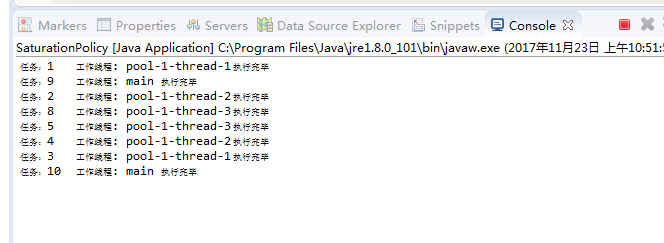线程池(thread pool) 是并行执行任务收集的实用工具。随着 cpu 引入适合于应用程序并行化的多核体系结构,线程池的作用正日益显现。通过 threadpoolexecutor类及其他辅助类,java 5 引入了这一框架,作为新的并发支持部分。
threadpoolexecutor框架灵活且功能强大,它支持特定于用户的配置并提供了相关的挂钩(hook)和饱和策略来处理满队列
java线程池会将提交的任务先置于工作队列中,在从工作队列中获取(synchronousqueue直接由生产者提交给工作线程)。那么工作队列就有两种实现策略:无界队列和有界队列。无界队列不存在饱和的问题,但是其问题是当请求持续高负载的话,任务会无脑的加入工作队列,那么很可能导致内存等资源溢出或者耗尽。而有界队列不会带来高负载导致的内存耗尽的问题,但是有引发工作队列已满情况下,新提交的任务如何管理的难题,这就是线程池工作队列饱和策略要解决的问题。
饱和策略分为:abort 策略, callerruns 策略,discard策略,discardolds策略。
为了更好的理解,我编写一个小的例子。
|
1
2
3
4
5
6
7
8
9
10
11
12
13
14
15
16
17
18
19
20
21
22
23
24
25
26
27
28
29
30
31
32
33
34
35
36
37
38
39
40
41
42
43
44
45
46
47
48
49
50
|
package concurrency.pool;import java.util.concurrent.linkedblockingdeque;import java.util.concurrent.rejectedexecutionhandler;import java.util.concurrent.threadpoolexecutor;import java.util.concurrent.timeunit;public class saturationpolicy { /** * 线程池工作队列已满时,在不同饱和策略下表现 * @param handler 线程池工作队列饱和策略 */ public static void policy(rejectedexecutionhandler handler){ //基本线程2个,最大线程数为3,工作队列容量为5 threadpoolexecutor exec = new threadpoolexecutor(2,3,0l, timeunit.milliseconds,new linkedblockingdeque<>(5)); if (handler != null){ exec.setrejectedexecutionhandler(handler); //设置饱和策略 } for (int i = 0; i < 10; i++) { exec.submit(new task()); //提交任务 } exec.shutdown(); } public static void main(string[] args) { // policy(new threadpoolexecutor.abortpolicy()); // policy((new threadpoolexecutor.callerrunspolicy())); // policy(new threadpoolexecutor.discardpolicy()); // policy(new threadpoolexecutor.discardoldestpolicy()); } //自定义任务 static class task implements runnable { private static int count = 0; private int id = 0; //任务标识 public task() { id = ++count; } @override public void run() { try { timeunit.seconds.sleep(3); //休眠3秒 } catch (interruptedexception e) { system.err.println("线程被中断" + e.getmessage()); } system.out.println(" 任务:" + id + "\t 工作线程: "+ thread.currentthread().getname() + " 执行完毕"); } }} |
当工作队列满了,不同策略的处理方式为:
1.abort策略:默认策略,新任务提交时直接抛出未检查的异常rejectedexecutionexception,该异常可由调用者捕获。
在主函数中添加如下代码:
|
1
|
policy(new threadpoolexecutor.abortpolicy()); |
运行结果为:

程序抛出了rejectedexecutionexception,并且一共运行了8个任务(线程池开始能运行3个任务,工作队列中存储5个队列)。当工作队列满了的时候,直接抛出了异常,而且jvm一直不退出(我现在也不知道什么原因)。我们可以看到执行任务的线程全是线程池中的线程。
2.callerruns策略:为调节机制,既不抛弃任务也不抛出异常,而是将某些任务回退到调用者。不会在线程池的线程中执行新的任务,而是在调用exector的线程中运行新的任务。
在主函数运行:
|
1
|
policy((new threadpoolexecutor.callerrunspolicy())); |
运行结果

所有的任务都被运行,且有2(10 - 3 -5)个任务是在main线程中执行成功的,8个任务在线程池中的线程执行的。
3.discard策略:新提交的任务被抛弃。
在main函数中运行
|
1
|
policy(new threadpoolexecutor.discardpolicy()); |

通过上面的结果可以显示:没有异常抛出,后面提交的2个新任务被抛弃,只处理了前8(3+5)个任务,jvm退出。
4.discardoldest策略:队列的是“队头”的任务,然后尝试提交新的任务。(不适合工作队列为优先队列场景)
在main函数中运行如下方法
|
1
|
policy(new threadpoolexecutor.discardoldestpolicy()); |
运行结果:一共运行8个任务,程序结束,后面添加的任务9,任务10被执行了,而前面的任务3,任务4被丢弃。

总结
以上就是本文关于java线程池工作队列饱和策略代码示例的全部内容,希望对大家有所帮助。如有不足之处,欢迎留言指出。感谢朋友们对本站的支持。
原文链接:http://blog.csdn.net/lixwjava/article/details/51813032

















